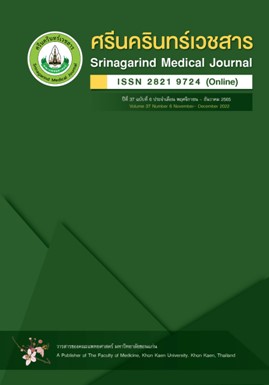ผลการจัดบริการดูแลผู้ป่วยระยะกลางในผู้ป่วยโรคหลอดเลือดสมองระยะฟื้นฟูที่โรงพยาบาลชุมชนแห่งหนึ่งในจังหวัดอุบลราชธานี
Outcomes of Intermediate Care Service in Stroke Rehabilitation Patients at A Hospital in Ubon Ratchathani Province
Abstract
หลักการและวัตถุประสงค์: โรคหลอดเลือดสมอง (stroke) เป็นโรคที่พบบ่อย และเป็นปัญหาสาธารณสุขที่สำคัญของประเทศไทยและประเทศอื่น ๆ ทั่วโลก ควรให้ความสำคัญกับการจัดบริการฟื้นฟูสมรรถภาพผู้ป่วยกลุ่มนี้ ดังนั้นการศึกษานี้จึงมีวัตถุประสงค์เพื่อศึกษาผลการจัดบริการดูแลผู้ป่วยระยะกลางในผู้ป่วยโรคหลอดเลือดสมองระยะฟื้นฟูในด้านความสามารถในการปฏิบัติกิจวัตรประจำวัน
วิธีการศึกษา: การศึกษาจากเหตุไปหาผลแบบย้อนหลัง กลุ่มตัวอย่างคือผู้ป่วยโรคหลอดเลือดสมองจำนวน 35 ราย ที่เข้ารับการรักษาในระบบการจัดบริการดูแลผู้ป่วยระยะกลางแล้วจำหน่ายจากการดูแลผู้ป่วยระยะกลาง ระหว่างวันที่ 1 มกราคม 2563 ถึง 30 เมษายน 2565 โดยผู้ป่วยจะได้รับการฟื้นฟูจากแพทย์ผู้ประกอบวิชาชีพเวชกรรมและนักกายภาพบำบัดที่ผ่านการฝึกอบรมการดูแลผู้ป่วยระยะกลางพร้อมกับทีมสหสาขาวิชาชีพ ใช้แบบประเมินกิจวัตรประจำวันดัชนีบาร์เธล (barthel index, BI) ฉบับภาษาไทยประเมินผลติดตามฟื้นฟูจนครบ 6 เดือน วิเคราะห์ข้อมูลโดยการแจกแจงความถี่ ร้อยละ ค่าเฉลี่ย ส่วนเบี่ยงเบนมาตรฐาน และเปรียบเทียบความสามารถในด้านความสามารถในการปฏิบัติกิจวัตรประจำวันด้วยสถิติ chi-square test, paired sample t-test และ repeated measurement ANOVA
ผลการศึกษา: ผลการศึกษาพบว่ากลุ่มตัวอย่างเป็นเพศหญิง ร้อยละ 51.43 อายุเฉลี่ย 56.14±13.98 ปี เป็นผู้ป่วยโรคหลอดเลือดสมองตีบ (ischemic stroke) ร้อยละ 85.71 หลังฟื้นฟูสมรรถภาพอย่างต่อเนื่องจนครบ 6 เดือน ผู้ป่วยมีความสามารถในการปฏิบัติกิจวัตรประจำวัน ทุกด้านเพิ่มขึ้นอย่างมีนัยสำคัญทางสถิติ (คะแนนก่อนและหลังฟื้นฟู เท่ากับ 6.11±5.78 และ 15.43±5.43 คะแนน ตามลำดับ และความแตกต่างของค่าเฉลี่ย เท่ากับ 9.31 คะแนน, p<0.001) ผู้ป่วยหายเป็นปกติหรือไม่มีการสูญเสียสมรรถภาพการปฏิบัติกิจวัตรประจำวันร้อยละ 25.71
สรุป: การจัดบริการดูแลผู้ป่วยระยะกลางทำให้ผู้ป่วยมีความสามารถในการทำกิจวัตรประจำวันเพิ่มขึ้น ควรพัฒนาระบบการดูแลฟื้นฟูผู้ป่วยตามบริบทความพร้อมของโรงพยาบาล
คำสำคัญ: โรคหลอดเลือดสมอง, ผู้ป่วยระยะฟื้นฟู, การจัดบริการดูแลผู้ป่วยระยะกลาง
Background and Objective: Stroke is a common, serious, and disabling global health-care problem, and rehabilitation is a major part of patient care. This study aimed to evaluate the outcomes of an intermediate care service, on daily living activities of patients with stroke rehabilitation.
Method: The retrospective cohort study consisted of 35 stroke patients who were discharged from an intermediate care service with intensive rehabilitation training by a multidisciplinary care team. which was proposed in the healthcare system between January 1st, 2020-April 30th, 2022. Barthel index (BI) of Thai version and return to daily living activities are used. Patients get rehabilitation and followed up until reach 6 months. Analyses of the data were to assess: frequencies, percentages, means, and standard deviations of population characteristics and to compare barthel index change with study variables by using chi-square test, paired sample t-test and repeated measurement ANOVA.
Result: The result showed that 51.43% patients were female and average age 56.14±13.98 years, which the most was ischemic stroke 85.71%. The comparison of BI change after discharge in patients who received the intermediate care program was shown statistical significantly increasing of BI (before 6.11±5.78, after 15.43±5.43, mean diff = 9.31, p<0.001), 25.71% of patient was physically independent.
Conclusion: It could be concluded that the patients with stroke, receiving the intermediate care service in a hospital could develop an ability to perform their activities of daily living much better than otherwise
Keywords: stroke, subacute phase, intermediate care service


